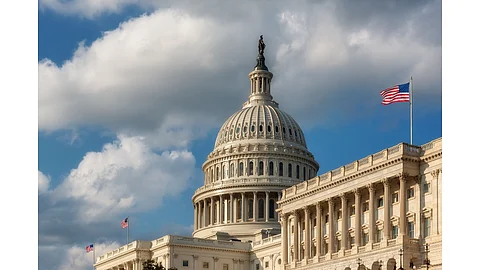

The US Senate’s draft bill proposes an early end to the solar and wind tax credits, phasing them out by December 31, 2027
It introduces a new tax on projects using foreign-sourced components, likely aimed at curbing Chinese supply chains
The industry continues to oppose the bill, saying it threatens clean energy investments and jobs
The US Senate’s latest budget bill draft, the One Big Beautiful Bill (OBBB) as it is called, unveiled just hours before a potential weekend vote, would repeal long-standing tax credits for wind and solar by 2027, but also subject these technologies to a tax, a surprise for the renewable energy industry.
The Senate version of the bill hastens the end of Investment Tax Credits (ITC) and Production Tax Credits (PTC) for solar and wind energy facilities, specifying that these will be available only to those projects that start commercial operations by December 31, 2027.
This deadline is even earlier than what the Senate Finance Committee proposed, which would have allowed projects using US-made components to receive the full ITC if construction starts by the end of 2025. Under that plan, the credit would then drop to 60% for projects starting in 2026, 20% for those beginning in 2027, and end entirely after that (see US Senate Finance Committee Proposal Risks Clean Energy Tax Credits).
The Senate version retains the Senate Finance Committee’s recommendation to end residential solar clean energy tax credits under Section 25D on December 31, 2025.
Residential solar leasing tax credits under Section 48E were denied in the Senate Finance Committee draft. The Senate version seems to have removed this denial provision, according to analysts at ROTH.
In addition, the Senate draft of the OBBB proposes a tax on wind and solar power projects that use ‘any material assistance from a prohibited foreign entity,’ which, in this case, most likely should be China. The language used in the Senate version reads, “(B) APPLICABLE FACILITIES.—The term ‘qualified facility’ shall not include any applicable facility (as defined in subsection (e)(4)(B)) for which construction begins after June 16, 2025, if the construction of such facility includes any material assistance from a prohibited foreign entity (as defined in section 7701(a)(52)).’’
It adds that the proposed tax will be applicable to qualified facilities in 2025 if these use more than 37.5% of equipment from a prohibited foreign country, increasing this threshold gradually to 60% by 2029.
Reactions
This is enough to add to the existing uncertainty in the sector. American Clean Power Association (ACP) called this surprise tax addition in the Senate version as ‘midnight dumping’. It fears that these taxes would freeze energy investments, reduce domestic energy production and drive up household energy bills.
“These new taxes will strand hundreds of billions of dollars in current investments, threaten energy security, undermine growth in domestic manufacturing and land hardest on rural communities who would have been the greatest beneficiaries of clean energy investment,” warns ACP CEO Jason Grumet.
Solar Energy Industries Association (SEIA) also issued a strong statement opposing the bill. SEIA President and CEO Abigail Ross Hopper said, “This reconciliation bill proposal isn’t just misguided — it’s a direct attack on American energy, American workers, and American consumers. It guts the very industries that are lowering electricity bills, revitalizing U.S. manufacturing, and building more new power capacity than every other energy technology combined.”
According to US market intelligence platform Cleanview’s project tracker, 2,332 solar and wind projects with a combined 547 GW are expected to come online in 2027 or later. North Carolina, which is expected to see an estimated 28 GW of new solar and wind capacity being built by 2035, will likely see the numbers slashed down to 14 GW, according to Cleanview.
“If this bill passes in its current form this weekend, it would lead to a wave of cancellations around the country,” claimed Cleanview’s Founder and CEO, Michael Thomas, in a LinkedIn post. Cleanview had previously projected 603 GW of planned renewable energy capacity scheduled to come online by 2028 or later to be derailed based on the House-passed bill (see Trump’s OBBBA Threatens Over 600 GW US Clean Energy Projects).
Founder of energy advisory firm Stoic Energy Doug Lewin believes that if the bill passes in its current form, developers will still build renewables in the country, but they will build ‘less of it, and it will be more expensive.’
In a statement, Sean McGarvey, the President of the North America’s Building Trades Union (NABTU), which represents 3 million US construction workers, said, “Slashing energy tax credits and layering on harmful restrictions is no way to power America’s future, economically or in terms of national energy security. Critical infrastructure projects essential to that future are being sacrificed at the altar of ideology.”
Nevertheless, there is still some way to go before the bill can become an act. An article in Forbes describes the process in detail. Here’s a step-by-step summary of the same.
Once past the debate in the Senate, the bill will enter into what is called a vote-arama wherein senators can introduce an unlimited number of amendments to a reconciliation bill or budget resolution and vote upon them. Once all of these amendments are voted on, the Senate will cast the final vote on the passage of the bill. It will then enter a Joint Conference Committee comprising representatives from both chambers – the House and the Senate – to sort out the differences. Once both chambers agree to a single, unified version of the bill, it will finally be placed on President Trump’s desk to be signed into law.
Trump aims to sign the bill into law by July 4, America’s Independence Day.
